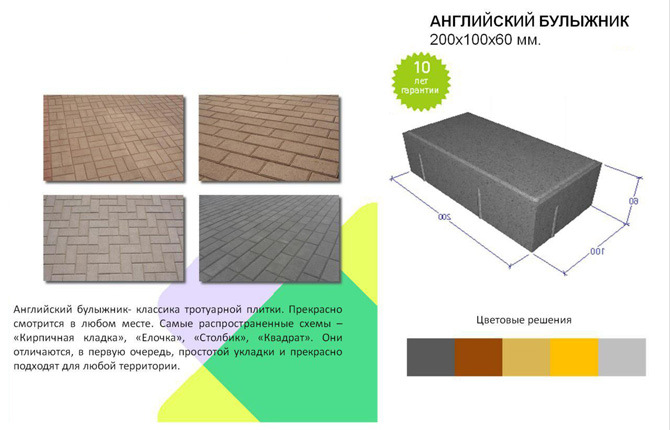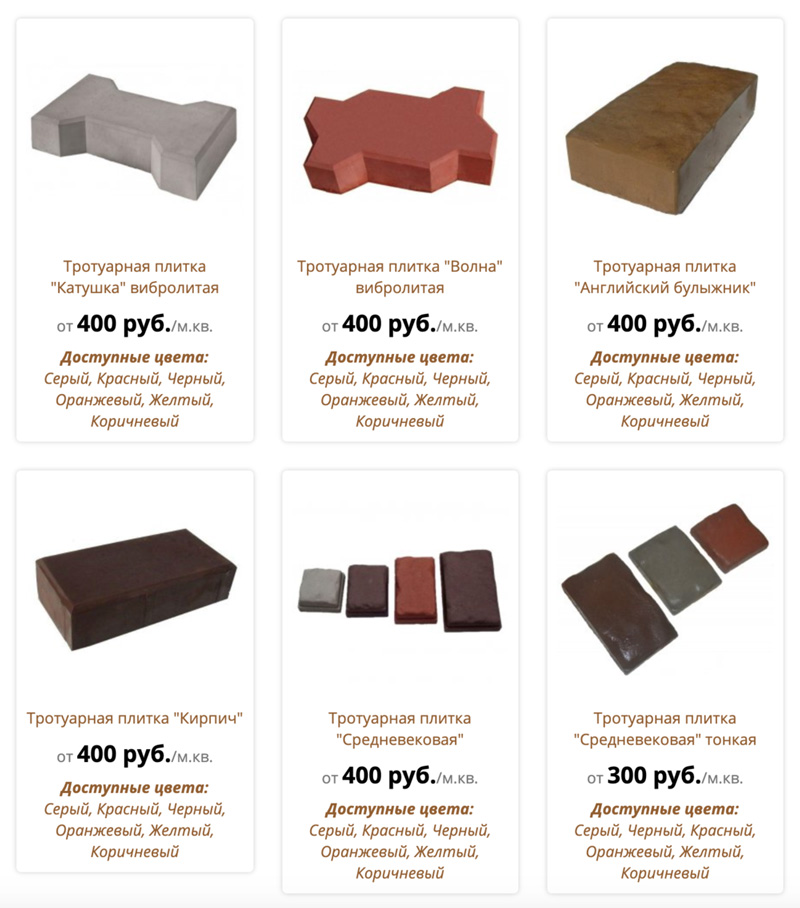Paving slabs “English cobblestones” - characteristics, features and installation method
Among the many tiles, “English cobblestones” is especially popular.It is known for its advantages, characteristics, and unique manufacturing method. Therefore, it is actively used in the construction and improvement of local areas, recreation areas, etc.
The content of the article:
Preparation method
The creation of “English cobblestones” differs from the production of other slabs by a special technology. It includes:
- cement mixture;
- fiber fiber;
- pigments;
- plasticizers that impart plasticity to the material.
The production of English cobblestone paving slabs includes several stages:
- The material, usually M500 cement mixture, is poured into standard-sized molds.
- Completed forms are placed on vibrating table. It is used to distribute the material and gradually remove air bubbles from the mixture. This helps to increase the density and strength of the tiles.
- Next, the mold is left in a warm, dry place until the mixture in it has completely hardened.
- The finished blocks are removed from the mold. They are ready to use.
During production, paving slabs are additionally given a certain color. The color palette ranges from light to dark. Popular shades are gray, sand, green, orange, etc.
Read also! How to make paving slabs with your own hands.
Characteristics and Features
The shape of the paving “English cobblestones” resembles a neat brick or a rectangular block. If we compare the external texture with brick, then the front surface of the cobblestone imitates natural stone with irregularities and roughness. In general, paving building materials resemble road paving stones.
The configuration of one “English cobblestone” was determined by specialists.It is important to calculate the length and width in order to plan the decorative layout, and the thickness in order to make the element as thin but durable as possible. Modern manufacturers strive to combine beauty and elegance with long service life.
Paving slabs "English cobblestones" can be shaped like:
- rectangular - 12x25 cm. The height of the product can vary from 4 to 6 cm;
- square - on the long side 16 cm.
Both forms of paving slabs have the same physical properties; they differ only from a decorative point of view. If desired, the standard shape of the “English cobblestones” can be changed. It is usually split or reduced to the required size using stone discs.
The identical rectangular shape of the sidewalk elements is convenient to use and store. They can be folded so that they do not fall apart and do not take up much space.
The simple shape of the "English cobblestones" allows the installers to lay out almost any pattern that the client wants. They note that paving slabs are convenient to quickly carry by hand and adjust the masonry (due to their small size and light weight).
Advantages of English cobblestone paving slabs:
- Non-slip, rough surface.
- Wear resistance, durability.
- The ability to withstand not only pedestrian but also constant vehicular traffic.
- Natural appearance due to uneven texture.
- The ability to withstand temperature changes, frosts, and the hot summer without loss of external qualities.
- Environmentally friendly and safe, so it can be used in the children's area. And also don’t worry about your pets – it’s harmless to them.
The "English cobblestone" paving path is famous for its natural stone appearance.The simple design adds elegance and laconicism to the yard, creating the atmosphere of an old castle, where natural stone was always used to lay roads. The building material received its unusual name because it is externally similar to elements of stone roads in European countries during the Middle Ages.
The yard is tiled with English cobblestones.
Method of laying "English cobblestones"
Thanks to the simple shape and lightness of the material, craftsmen create unusual patterns, ornaments and unique details in the process laying paths.
Classic types of laying paving bricks:
- longitudinal or linear - parts are laid in the direction of the track;
- transverse - the largest side is located across the path;
- herringbone - the short side of the element is adjacent to the edge of the long side of the adjacent tile;
- well – four standard cobblestones are laid out in a square with a “well” in the middle. Another half of the tile covers the space in the square;
- diagonal - longitudinal or transverse masonry is rotated 45 degrees, and the pieces that come out are cut off with a grinder;
- checkerboard - a combination of longitudinal and transverse laying of tiles in pairs.
Before installing paving slabs, craftsmen carry out markings and plan the future path. Pegs are driven into the ground, to which cords are attached, indicating straight sections. If the path is planned with smooth turns or meanders, then markings on the ground are made using a lime-based solution.
According to the markings, the top layer of soil is removed - up to 60 cm deep. Such a spatial box allows you to prevent shrinkage of paving material into the ground. Then it falls asleep sand, crushed stone or fine granite. The resulting bottom layer is strongly compacted manually or using a special device.
It happens that a cement-sand or concrete base is used - it depends on the desired location for creating the path and the initial quality of the soil. It is better to first consult with a specialist who will give advice on the main foundation material, with which the “English cobblestones” will last as long as possible.
If necessary, trenches for curbs are made. A separating layer of geotextile is installed under them. The curb slabs themselves are inserted into the fixing solution.
Then a mandatory check is made and the base is leveled so that the tiles lie on the same level. When everything is prepared and checked, the cobblestones themselves are laid, forming the desired pattern.
The tiles are practically not connected to each other, so they are additionally sprinkled with coarse sand seams. The excess is brushed off with a broom or broom. The path is being compacted.
Laying paving stones "English cobblestones" in the video.
About the price
The production of “English cobblestones” does not require expensive materials or equipment, so it is considered a cheap product, despite the quality, which is not inferior to tiles from the expensive price segment. Natural stone is most valued, but it is also the most expensive. Not everyone can afford this. And the bumpy surface of the cobblestone allows you to imitate natural textures, which immediately makes it more attractive in appearance.
The average price per square meter is from 400 rubles, depending on the manufacturer and its additional markups. Approximate calculations say that for laying 1 sq. meter you will need about 32 tiles.
Any owner of a summer house or country house wants his yard to look stylish.Paths made from “English cobblestones” combine expensive natural texture, versatility, strength and durability, and accessibility. If your skills and abilities are not enough to lay a path, you should contact the experts.
Do you like this building material? Bookmark the article and share it on social networks.
Sources:
- https://deal.by/Trotuarnaya-plitka-anglijskij-bulyzhnik.html
- http://cemgid.ru/samostoyatelnyj-montazh-bruschatki-anglijskij-bulyzhnik.html
- https://protrotuarnujuplitku.ru/trotuarnaya-plitka/anglijskij-bulyzhnik.html
- https://tplitka.com/trotuarnaya-plitka/anglijskij-bulyzhnik









At our dacha, the paths in the garden are made of these tiles. For almost 5 years they have been serving faithfully. No cracks, chips, look great! And back then tiles were still cheap. That’s why I never regretted that I persuaded my husband to take part in “English Cobblestones”.
But I believe that you cannot save on home improvement. It’s better to spend money and make a layout from stone than from such cheap tiles that will fall apart in a couple of years.
Where did you get the idea that it would fall apart? Have you or someone you know fallen apart? Try first and judge later. My neighbors over there paved their yard with it a couple of years ago. They just walk around and park the car, but the tiles don’t care. Now I’m thinking about laying out my yard like this.